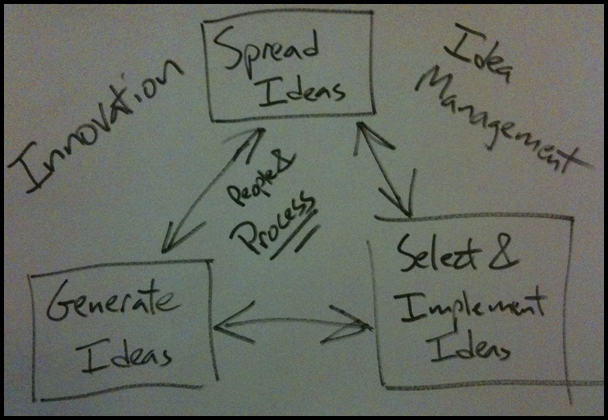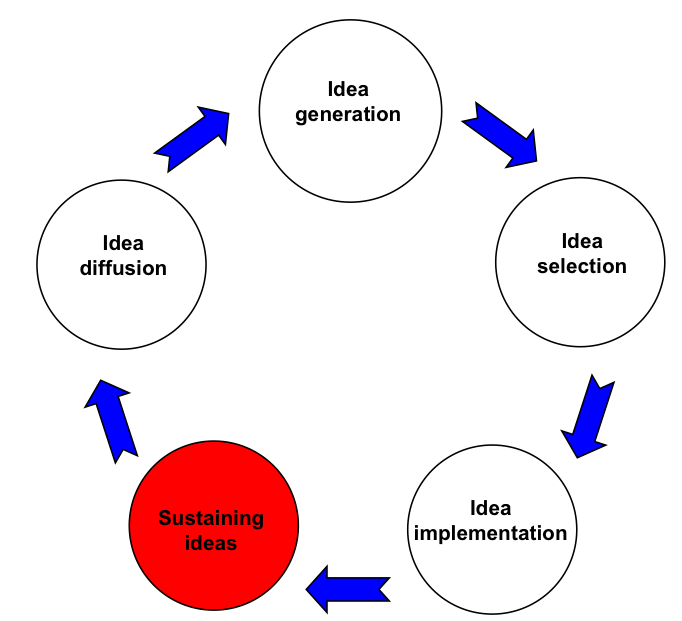
Innovation Big and Small
Can big companies innovate?
Of course they can. Even though that question has been getting asked a lot recently, it’s not really a very interesting one. It actually goes back at least to Schumpeter, who thought about the issue throughout most of his career. He famously changed his mind on the question of big versus small, mainly because the process of innovation changed during that forty year period.
A much more interesting and useful question is: what can my organization do to be more innovative? The point is that innovation is not deterministic – you’re not doomed if you’re big, and you’re not automatically innovative if you’re small. The critical issue to figure out how innovation fits with your strategy and then what skills and processes you need to innovate in your particular context.
Size becomes important when you think about context – the way that you innovate will be different if you are big than it will be if you are small. No matter what the context, innovation is a process – it’s the process of idea management. I’ve pictured it something like this:
However, in the excellent report on public sector innovation in Australia, Empowering Change (downloadable here), led by Alex Roberts, they had a slightly different version of this model. It was adapted from a report on public sector innovation from Deloitte, and theirs looks like this:
I made the fourth circle red, because that is the one that I’ve always had some trouble getting my head around. But some of my recent discussions have given me some insights into this. The report describes Sustaining Ideas as “keeping the innovative initiative going and integrating it, which includes monitoring and adapting where necessary .”
This ends up being one of the key areas where innovation is different for big and small organisations. If you are a startup, you don’t need to worry too much about sustaining innovation initiatives. If you fail to do this, you go out of business. Simple enough.
But if you’re big, you have plenty of other things to worry about. You have quarterly objectives to meet. You have other processes you need to make more efficient. And so on. Not so simple. So if you’re big, and you’re trying to innovate, a lot of effort needs to go into this part of the idea management process.
So while big firms can indeed innovate, this means that they need to manage the process differently – there’s no one-size-fits-all solution – sorry! If you’re big, what are some of the things that you should do? Here are some ideas:
- Increase your innovation speed. If you’re going to innovate like the small, agile organisations, then you need to act more agile yourself. Here’s Phillips again, in a different post on the importance of velocity in innovation:
If these assumptions are true, then VELOCITY, as defined as speed in a specific direction, becomes very important for a firm’s ability to grow and compete. Relying on long product life cycles is not an option. Customers will demand new products, new features at an ever increasing rate. Firms can’t simply “dump” older technologies and products into “developing” markets because those market too understand the product/feature acceleration and reject older products.
Phillips recommends innovating your product development process, making innovation a core part of your strategy, and building executive support for this vision as the three critical steps to achieve this. - Open up!Think about the five steps in the innovation process model. What are big firms good at? They are great at getting things to market – that’s how they’re big. So they have idea diffusion covered pretty well. But this is often a huge problem for smaller organisations. They might have brilliant ideas, that have been executed very well, but they can’t get anyone to pay attention to them. How do they get around this? Collaborate.That’s the point that Ralph Ohr raised in his recent post, and Scott Anthony makes a similar point:
- WSJ: Are you saying startups are no longer capable of innovation?
Anthony: I don’t want to go so far as to say startups are pointless. But today, the second a startup has had a taste of success, the race is on, because anyone can copy them.
WSJ: What’s in store for these smaller companies then?
Anthony: They have to recognize their success can’t be predicated on the stupidity or slowness of big companies. It might be time to start thinking about partnering with a big company instead of just being pirates.
- Get to know your customers deeply. Often, big firms resist innovation because they think that they know best. But one of the things that they can do with their extra resources is invest more in learning what their customers really need. And you don’t do this through focus groups – you build deeper knowledge than that. One way to do this is to follow the customer home – as Soren Kaplan explains:
- Intuit’s innovation success is tied to a value for finding and savoring customer surprises–unexpected insights about customer needs, problems, and desired experiences that can’t be anticipated or pre-defined. That’s why the company does customer “follow-me-homes,” where everyone from CEO Brad Smith to engineers and marketers immerse themselves in the customer’s natural environment to see how things are working (or not) in the real world.
This is actually one of the techniques of ethnography, something that PARC has been investing in over the past few years. Ellen Isaacs from PARC talks about how this works:
With ethnography, you’re more interested in what people do than what they say (usually two different things), and you’re more likely to come out of it with answers to questions you didn’t know to ask. At its best, ethnography uncovers “aha!” insights that transform thinking. But since nobody knows know what they’ll learn, there’s no guarantee — and that makes people nervous.
The issue isn’t big versus small. And size doesn’t determine whether or not you can innovate.
The question to address is: What’s best for us? And the key point is that the answer will probably be different if you’re big.

Tags: Innovation, Leadership Development, Leadership Engine, Tim Kastelle














